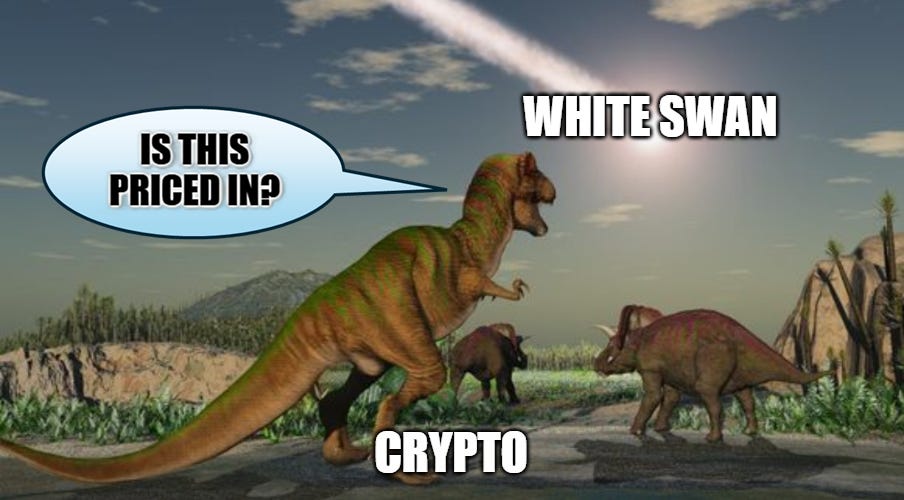Crypto Value Factors
What is priced in?
Why do cryptocurrencies have the values (prices) they do today?
Is it all just a giant scam? Overall I say, “no.”
Is it some irrational mania? Overall I say, “no.”
Is it a broad and diverse market assessment weighing and reweighing important factors as more information comes to light? I say, “certainly yes!”
Hence, this applies varyingly to different cryptocurrencies and tokens. Some have substantial use value or some other theoretical case behind them. Others are scams, mistakes, greater-fool-theory manias, or (very often) something other than financial products.
Tokens largely fall into this last category as they operate as souvenirs or memorabilia including vibe status symbols. They also operate as fan appreciation that might be benign, like just another way to tell Donald Trump you love and align with him, or might be ways around bribery laws, as Noah Smith outlines here.
For the most part I am ignoring tokens in this piece focusing on the more serious cryptocurrencies like Bitcoin, Ethereum, and similar others.1
So what factors are driving prices and how might they change as the future unfolds?
The point of this exercise is severalfold:
Think about the critical factors and what impact they would have (direction and magnitude).
Consider how these may or may not be priced in already. If they aren’t, why? If they are, also why and how?
Think about the consequences of a factor coming to fruition or just growing more likely as well as being diminished or eliminated. Based on the direction, impact, and degree ex ante this will have interesting implications for price movements including volatility. Pricing in more fully has impact, but elimination of a factor might have more since most of these are already greatly priced in. For example, eliminating a factor that is Lower, Very Big, and 99% Priced In would cause a huge jump in the price of the crypto.
Understand the potential interactive effects factors may have on one another including when there are none.
How to read the table: If a factor has a Higher price implication, the Degree to which it is priced in will tell you the degree to which the current price is elevated supported by this factor. For Lower, the Degree tells you how much it is held back in price currently. The middle category of Impact tells you by how much the price is elevated or restrained.
Fully pricing in a higher/lower-direction factor doesn’t do much if the impact is small. Partially pricing in a higher/lower-direction factor does a lot when the impact is very big.
BEWARE: Do not misinterpret the Degree to be my probability assessment. These are not the chances each scenario comes to be in my estimation. These are my guesses as to the degree to which each is priced in—my guess as to the probability the market assigns to each.
Think of it this way. I could tell you that I guess the betting market is pricing in about a 20% chance that Ohio State repeats as college football national champion in 2025. This doesn’t tell you anything much about the chances I assign to it.
There is certainly some joint interaction among these factors/categories. Analyzing that is beyond the scope of this post. Just accept that these are not mutually exclusive.
The list is also not jointly exhaustive. I very well have left out something big.
All of this is provisional. I stand ready to revise my percentages for sure and likely my impact magnitudes. I was thoughtful in building this, but I didn’t go much past first-order thinking on it.
My initial reading of this is that a lot of the upward price support is already priced in, but not all of it is. Also, a substantial amount of price detraction is priced in leaving room for these Lower factors to either die out (increasing crypto prices) or come to be (decreasing crypto prices).
As they say, we’ll see . . .

Update 2025-02-15:
Upon reflection of this post after an unrelated Q&A session following a presentation I made, it occurs to me, just like I suspected, that I did in fact leave out something big. Namely, the possibility that even if crypto works, those gains are all captured by society and users rather than investors (owners). This is particularly frustrating to me since this was a subject of a former post of mine.
Here is the updated table.
The thinking behind this new category, which is at the very top of the table, is that as with lightbulbs, indoor plumbing, computers, and so much else the overwhelming majority of the gains from cryptocurrencies might simply accrue to consumers.2 Notice how I believe the majority of what is already priced in is supportive to crypto prices—not a bullish estimate going forward for sure.
I have also included a calculation for how much is not priced in. This gives some perspective on upward and downward potential when paired with the priced-in summaries.
Think of Dogecoin somewhere in between. It could be a transactional currency, etc.



